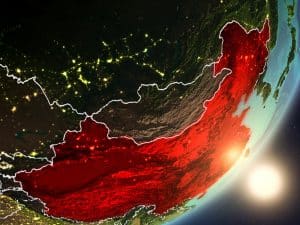So far in 2020, world “public opinion” about China has run the gamut. China first took a beating for its handling of Covid-19. It was subsequently praised when the pandemic spread across the globe, other countries were clearly worse off, and China was saluted as a savior for its “humanitarian” aid in the form of test kits, masks, ventilators, and other donations sent around the world. Then, when tens of thousands of those diagnostic kits sent to other countries failed, China was ridiculed. This is one example of the (intentional) cyclothymia1Translator’s note: Cyclothymia is a type of chronic mood disorder that is typically considered within the medical community to be a form of bipolar disorder. that plays out in how the Asian giant is covered in the international press. This also extends to any analysis of the challenge China could pose to the imperialist powers.
China in the World Capitalist System
In 2013, Perry Anderson wrote that with the emergence of China, “the logic of long-term American grand strategy threatened to turn against itself. Its premise had always been the harmony of the universal and the particular — the general interests of capital secured by the national supremacy of the United States.” But under these new conditions, “American primacy is no longer the automatic capstone of the civilization of capital.”2Perry Anderson, “Imperium,” New Left Review 83 (September/October 2013), 111. For a critical reading of the two articles in that issue, “Imperium” and “Concilium,” see Esteban Mercatante, “El imperio contraataca” [“The Empire Strikes Back”], Ideas de Izquierda 6 (December 2013); and Mercatante, “EE. UU.: ¿jugador solitario en el gran tablero global?” [“United States: Lone Player on the Great Global Game Board”], Ideas de Izquierda 8, April 2014.
Seven years later, the trend it described has deepened frenetically, just as Donald Trump launched a “trade war” with China soon after winning the U.S. presidency in 2016. This war has had its ups and downs due to the president’s changing political needs, but has at its core the strategic interests of containing China and the battle for technological primacy. These interests are shared even by the majority of the political and economic establishment that does not adhere to Trump’s “America First” slogan, and because of the underlying objective even finds support in the European Union and Japan despite distrust of the orange-haired president, and even if they question the tools he employs for the strategy.
The “rise” of China, which had as a sine qua non the national unity achieved through the 1949 revolution, was supported by the internationalization of production undertaken by capitalism beginning in the late 1970s (driven by the big multinationals to increase their levels of profitability by exploiting the cheap labor force the world over). This allowed China to be an exceptional case of “exacerbated unequal and combined development.”3Juan Chingo, “Mitos y realidades de la China actual” [“Myths and Realities of Today’s China”], Estrategia Internacional 21 (September 2004). Because of the peculiar combination of massive economic backwardness (which offered “virgin” land for investment) and a large pool of potential low-wage labor thanks to the huge rural percentage of the population, China was seen as the possible Mecca for the so-called global value chains that began to take shape in the 1980s and developed rapidly through the 1990s.
On this basis, China has been committed for at least 15 years to achieving an alchemy unheard of for any late-industrializing country in the second half of the 20th century or thus far in the 21st century: getting out of the so-called “race to the bottom” that characterizes the type of competition the most backward economies have been forced to enter in order to attract capital — offering the best conditions for businesses (lower taxes, lower wages, customs-free zones, limited environmental regulations) in exchange for environmental and social dumping4Translator’s note: The term “social dumping” is of uncertain origin, but came into widespread use during the negotiation period for the North American Free Trade Agreement (NAFTA). The European Commission itself defines it as “the practice whereby workers are given pay and/or working and living conditions which are sub-standard compared to those specified by law or collective agreements in the relevant labour market, or otherwise prevalent there.” — so it can join the “race to the top” in terms of value generation and development. According to Enrique Arceo, South Korea and Taiwan (which the Chinese state aims to reintegrate fully someday) are among the few relatively successful cases that, “although they have not ceased to be peripheral countries,” have nevertheless “initiated a sustained process of building an industrial system,” a concept the author contrasts with the disjointed industrialization that characterized most of the investments linked to global value chains.5Enrique Arceo, El largo camino a la crisis [The Long Road to the Crisis] (Buenos Aires: Cara o Ceca, 2011), 219. In an effort to emulate the results of these few “successful” cases from the last half century of development through export industrialization, China — which has long been the main industrial exporter — has been promoting and achieving a slow but sustained increase in the level of local integration of production (i.e., it is less and less a center for the assembly of components brought in from factories in Korea, Taiwan, Singapore, and other countries). China is distinguished from the other countries just mentioned by the predominance of state-owned enterprises (SOEs) that have been, since the late 1980s during the second period of opening reforms, “displacing and subjugating the private sector” that had emerged from the turn initiated under the leadership of Deng Xiaoping in 1978.6Ho-fung Hung, The China Boom: Why China Will Not Rule the World (New York: Columbia University Press, 2016) 61. For a commentary on the book, see Esteban Mercatante, “¿China no dominará el mundo?” [“Will China Not Rule the World?”], Ideas de Izquierda 33 (September 2016).
But China is not South Korea or Taiwan for another fundamental reason: it is the most populous country on the planet. Its entry alone into the global circuits of capital contributed to half or more of the global “doubling of the workforce” that has been much discussed in recent decades, and its efforts to move up in the rankings of economic powers are, in terms of scale, just as disruptive. It is the second-largest economy in the world measured by gross domestic product and may overtake the United States in the next decade,7It already achieved the status of largest economy several years ago if the GDP is measured in terms of what is called purchasing power parity (PPP), which consists of adjusting the value of production based on the prices of a reference country. PPP is intended to make the quantity of goods and services generated in different countries more homogeneously comparable. although its productivity is still far from that of developed economies; and even if it had not set out to do so, its growing prominence would inevitably be seen by rich countries as a threat to their dominant position. Because of its role in global industrial exports and, increasingly, the size of its market, China has been able to secure — with mixed success — technology transfer agreements (when not outright stealing intellectual property).
The watershed came in the conditions after the 2008 economic crisis. China’s export growth was counterbalanced by high U.S. consumption, largely supported by debt. This collapsed during the recessionary years, and then reactivated at a rate insufficient to sustain China’s growth, which remained above 7 percent per year until 2015. Since the crisis, there has been talk of the Chinese Communist Party bureaucracy’s attempt to “rebalance” the economy so that it would rely more on domestic demand. But this ended up leading to excess investment (with rates that reached 50% of GDP from creating underutilized infrastructure) while consumption remained weak. Outside the middle sectors and an elite that became millionaires in the heat of capitalist development, wages have remained at low levels internationally, even though they have increased considerably from the levels of 20 years ago. This is what explains the launch of the new Belt and Road Initiative (BRI), aimed at being a new “Silk Road,” in an attempt to create an integrated global space to absorb more Chinese goods and to dump investments. But even before the BRI, Chinese investments in sectors as varied as agriculture and mining as well as building infrastructure were spreading all over the world, in some places — like the African continent — surpassing the presence of the United States or the European powers. If there are some who still harbor the illusion that China can counterbalance the imperialist powers by playing a more “benevolent” role towards the poor and developing countries,8We argued against this idea in Eduardo Molina and Esteban Mercante, “El ‘factor chino’ en Latinoamérica” [“The ‘China Factor’ in Latin America”], Ideas de Izquierda 17 (March 2015). its performance in these countries belies this, as it is reminiscent of the role played by European countries in the 19th and early 20th centuries.
The Great Recession also pushed China and the United States to position themselves more clearly as competitors. Although the Pentagon and American think tanks had already developed conflict scenarios and containment strategies,9Giovanni Arrighi documented these in his book. See Adam Smith in Beijing: Lineages of the 21st Century (Verso, 2007). the crisis was a watershed. Obama’s denunciations of “currency manipulation” began to become more emphatic, occurring just as the United States was flooding the world with dollars through its “quantitative easing” to push the U.S. economy. 10Translator’s note: Quantitative easing involves a central bank buying predetermined quantities of government bonds or other financial assets as a way to inject money directly into a national economy. Trade agreements aimed at excluding China (the Trans-Pacific Treaty) also proliferated in those years. On the Chinese side, Xi Jinping led the country through a more nationalistic turn that had already been outlined in previous years, and he became an increasingly aggressive player on the international stage. When Trump became president, with his “America First” slogan and the “trade wars,” U.S. foreign policy changed in many respects. But with China, it simply escalated, putting trade barriers (rather than simply excluding China from agreements with other countries) at the center of the dispute.
Since the 2000s, the Asian giant has made every effort to strengthen the growth of its “national champion” companies. By supporting the expansion of these firms around the world, China increasingly seeks to play the same game the imperialist powers have played in recent decades: the concentration and centralization of capital around the world, which allowed multinational firms to consolidate their dominance of the value chains and take advantage of wage differences and competition between countries to attract capital by lowering taxes and granting other concessions, and thus appropriate a larger share of the surplus value generated around the world (which ends up sheltered in tax havens).
As if this were not enough, in recent years China has begun to thrust itself into the field where the United States has based its primacy: technological innovation.
China’s Global Position, By the Numbers
China is, after the United States, the main destination for foreign direct investment (FDI) — capital flows between countries for productive ventures or buying companies. The United States received 16 percent of global FDI in 2019 and China got 13.6 percent. But at the same time, and unlike a decade ago, FDI from China to the rest of the world has become a very considerable amount. The leader in FDI outflows in 2019 was Japan (which has been alternating with the United States for the lead), which accounted for 17 percent of outward FDI flows. It was followed by the United States (9.5%), the Netherlands (9.4%), and China in fourth place (8.9%). Because of its historical position as an investor, the United States lags far behind when it comes to accumulated FDI: U.S. imperialism accounts for 22 percent of total investment abroad, followed by the Netherlands (7.3% of the total), China (6%), and Japan (5.2%). Of course, in this era of global value chains, FDI is a figure that must be considered with a grain of salt. Much of the expansion of multinational firms has been through subsidiaries, with which they establish contracts but without any ownership or shareholding relationship that links them. If we take into account only investments, we may be underestimating the leadership and control of global production held by large firms in the United States, the European Union, and Japan.
In 2013, China counted only 14 companies among the Global Fortune 500. By 2019, by my own calculations based on the most recently published list, it had 119, surpassing the United States’ 99. If we compare these U.S. firms with those in China, we see that even with 20 percent fewer companies on the list, the U.S. firms generated more revenue ($8.7 trillion compared to $7.9 trillion for the Chinese firms) and did so while expending fewer assets, which means they are more profitable. But the American firms are even more profitable in absolute terms: the $670 billion combined profits of the 99 U.S. are 61 percent higher than those of the 119 Chinese firms. In other words, a comparison of both countries companies with respect to “efficiency” reveals that the American firms have, as a whole, several advantages.11Translator’s note: This paragraph has been revised from the original based on a discussion between the author and the translator.
When looking at innovation performance, we see similar results. China’s undisputed advantage with Huawei in 5G, a technology that promises to be the key to the Internet of Things and with multiple security implications, set off all the alarms in Washington.
In 2019, for the first time, China became the largest user of the international patent system, filing 58,990 applications. It was followed by the United States (57,840), Japan (52,660), Germany (19,353), and South Korea (19,085).
In the rankings published in 2019 by the European Commission of the 2,500 firms in the world that invest the most in research and development (R&D), China had the second-most (507) after the United States (769), followed by Japan (318) and Germany (130).12Joint Research Centre (European Commission), “The 2019 EU Industrial R&D Investment Scoreboard” (Luxembourg: Publications Office of the European Union, 2020). All data in this paragraph are extracted from this document. But when it comes to actual spending, China is relegated to third place: American firms spend the equivalent of 312 billion euros, Japan’s spend 109.4 billion euros, and China’s only 96.4 billion euros. Germany, with a third of China’s firms among the 2,500, has an R&D investment of 82.9 billion euros, which is quite close.13Great Britain, with almost as many companies as Germany among the 2,500, has a significantly lower investment of 29.3 billion euros. China has many firms in the ranking, but only two in the top 50: Huawei (5th), and Alibaba (28th). The United States has 22 in the top 50, Germany 8, and Japan 6. South Korea has only 1, but it is Samsung, which ranks second in the world among firms that spent the most on R&D in 2019, behind Alphabet (Google) and just ahead of Microsoft.
When we compute the aggregate R&D expenditure of companies per country, U.S. companies account for 38 percent of the total, EU companies 25.3 percent (with Germany alone accounting for 10.1%), Japan 13.3 percent, and China 11.7 percent.
As we can see, the United States continues to lead in this area, with Japan, China, and Germany far behind. Huawei and Alibaba are not alone, but the technological gap persists, although there are sectors such as artificial intelligence14Kai-Fu Lee’s book AI Superpowers: China, Silicon Valley, and the New World Order (Boston: Houghton Mifflin Harcourt, 2018) provides an overview of the relative strengths of the United States and China in different dimensions of artificial intelligence development. and 5G in which the competition is beginning to become head to head.
Vulnerabilities
The United States appears to have made a dent in the dispute over 5G after the U.S. Department of Commerce issued a ruling on May 15 prohibiting the use of U.S. technology in providing chips to Huawei. The ruling affects Cisco and Qualcomm, as well as Taiwan Semiconductor Manufacturing Co. Ltd. (TSMC), the world’s largest producer, which had the Chinese firm among its largest customers.
The fact is that the undisputed leadership of the Chinese with respect to 5G networking does not extend to key components such as the chips. China’s projects underway to develop them lag several years behind.
At the same time as it issued this ruling, the United States has been encouraging European telecom giants such as Nokia and Ericsson to redouble their efforts to develop 5G. Both companies have increased their own purchases from TSMC, which actually suffered no setback from not selling to Huawei.15Tim Culpan, “TSMC Shrugs off Huawei Ban and Shows Who’s King,” Bloomberg, July 16, 2020.
This has already cost China a strong chance to expand its 5G contracts. In the middle of this month, Great Britain announced it would exclude Huawei as a supplier, contrary to what had been announced months earlier. This is not exclusively due to pressure from Washington, which until a few months ago had not prevented China from signing agreements with other countries that saw abstaining as more risky than provoking the United States. “Because U.S. technology is used to manufacture the advanced semiconductors that Huawei’s products, including 5G base stations, require, the company’s supply will be cut off,” writes Minxim Pei, “making production of its 5G equipment in the future nearly impossible.”16Minxin Pei, “China’s Deepening Geopolitical Hole,” Project Syndicate, July 16, 2020. This will not stop China’s development of 5G, but it may give competitors some time to close the gap.
China’s dependence on foreign technology has created difficulties in the past for China in areas where it has concentrated tremendous effort. Wind turbines are a good example, but it was able to obtain a key contribution from General Electric in that sector because of the weak demand the company was facing in the United States and elsewhere, which forced GE to “tradeoff … short-term sales for long-term competition.”17Kathryn Kranhold, “China’s Price for Market Entry: Give Us Your Technology, Too,” Wall Street Journal, February 26, 2004. As Jianyong Yue observed, this not only allowed China to obtain the technology, but also allowed its companies to aggressively export “high-tech products at extremely competitive prices to the global market that was traditionally dominated by its foreign partners.”18Jianyong Yue, China’s Rise in the Age of Globalization: Myth or Reality? (London: Palgrave Macmillan, 2018), 293. But this was a short-lived success, since, as the Wall Street Journal noted, “After the partnerships [with GE and other companies] expired, many of the Chinese partners couldn’t succeed independently.” This was because “the most secret elements of the turbine, including the design of the cooling system for the first row of blades and the technology behind a thermal protective coating for those blades” were not transferred to the partners in China. Furthermore, the turbines designed by the company at the time the technology transfer was agreed to were “at least two generations ahead” of those sold to China, according to Jeffrey R. Immelt, the company’s chairman and CEO at the time.19Kranhold, op. cit. Given such persistent lags in important categories such as control systems and turbine support software, Yue drew this conclusion: “Whether the ‘grown-up’ Chinese firms will be able to catch up through self-reliant innovation and even outcompete foreign players on the global market afterward remains an outstanding issue.”20Yue, op. cit., 294
It’s much the same with high-speed trains. The Japanese firm Kawasaki and the German company Siemens were some of the partners with which Chinese firms sought to develop this industry and appropriate the “knowhow.” Kawasaki actually transferred the key technologies to its subsidiary in the form of joint ventures with Chinese partners, but Siemens did not share that with the local firms.21Yue, ibid., 296, citing China Business Weekly, March 2006. The most innovative remained under firm control of the Japanese, while “the Chinese partners were devoted to assembling the less-sophisticated secondary components. Bai Yimin, a well-known business analyst who had worked in Mitsui for years, described such adaptive strategies of Japanese firms’ technology transfer as ‘Made in China, but Made by Japan’.”22Yue, ibid., 296, citing Bai Yimin, Mitsui Empire in Action (Beijing: China Economic Publishing House, 2008), 262. Similar terms were used by Siemens; the German business press reported that managers at the company had said the company holds “exactly the same attitudes as those of Tysen Krupp and Airbus [and] will not and never concede cored technologies [to China].”23Yue, ibid., 296, citing 21st Century Business Herald, March 23, 2011. These statements could be viewed simply as gestures to calm any nervousness among Germany’s elites, but it was indeed confirmed by experts in high-speed train construction in China, who say that the country’s firms are still far from being able to develop things on their own. In this case, the associated multinationals also transferred less-critical technologies to meet the requirements of the authorities, retaining the most sophisticated knowhow and intellectual property rights on the most fundamental technologies. Only an estimated 20 percent of the trains manufactured in China have proprietary intellectual property rights — that is, they are not subject to patent payment or other restrictions.24Yue, ibid., 296, citing New Beijing Daily, June 14, 2011.
Notwithstanding the speed with which China has closed the gap, and although “global firms dominate the high-end manufacturing and monopolize key technologies, they are increasingly sensitive to the likelihood that China will catch up much quicker than expected through whatever means and become their most dreadful competitor in the near future.”25Yue, ibid., 296–7.
A Long March
In the months between now and November, the “trade war” and other moves against China will be subjected to the shifting wings of the election campaign, as electoral swings, as has always been the case with Trump. But even if Trump loses, as all signs currently indicate, it is doubtful that the conflicts of recent years will de-escalate. The United States will continue to do everything possible to rub salt into the wound of all the diplomatic tensions that have been escalating dangerously in Beijing, especially with India, Australia, and Japan, and make use of internal crises such as the one in Hong Kong that resurfaced last month when the Chinese government imposed a new security law on the island.
Today, when the United States has been challenging various aspects of the transnational capitalist order it built after the end of World War II (while at the same time retaining any prerogatives that might benefit U.S. companies) as a way to fight more aggressively to sustain its leadership, the challenge is not that China will attack this order but rather that it poses a threat to the position of the United States and other powers. China’s goal of continuing to increase its influence and advantages within that order increasingly involves questioning the “exorbitant privileges” of the main power, especially attacking the disproportionate monetary and financial prerogatives the United States maintains (see this recent blog post by Tony Norfield.).
Undoubtedly, China still has a long way to go and will face more resistance from the great powers to any change in the status quo. If there is any doubt about that, the last few years show that this path will be fraught with internal and international upheaval and will inevitably not be a peaceful one. It has been one of the greatest sources of geopolitical tensions in recent times, and will continue to be so even if Trump (the other great disruptor) leaves the scene if he is defeated in November. The prospect is even bleaker with the current crisis. Its full scope is uncertain, but it already surpasses the ravages of 2008 and promises to exacerbate all the already-existing geopolitical tensions.
First published in Spanish on July 26 in Ideas de Izquierda.
Translation by Scott Cooper
Notes
| ↑1 | Translator’s note: Cyclothymia is a type of chronic mood disorder that is typically considered within the medical community to be a form of bipolar disorder. |
|---|---|
| ↑2 | Perry Anderson, “Imperium,” New Left Review 83 (September/October 2013), 111. For a critical reading of the two articles in that issue, “Imperium” and “Concilium,” see Esteban Mercatante, “El imperio contraataca” [“The Empire Strikes Back”], Ideas de Izquierda 6 (December 2013); and Mercatante, “EE. UU.: ¿jugador solitario en el gran tablero global?” [“United States: Lone Player on the Great Global Game Board”], Ideas de Izquierda 8, April 2014. |
| ↑3 | Juan Chingo, “Mitos y realidades de la China actual” [“Myths and Realities of Today’s China”], Estrategia Internacional 21 (September 2004). |
| ↑4 | Translator’s note: The term “social dumping” is of uncertain origin, but came into widespread use during the negotiation period for the North American Free Trade Agreement (NAFTA). The European Commission itself defines it as “the practice whereby workers are given pay and/or working and living conditions which are sub-standard compared to those specified by law or collective agreements in the relevant labour market, or otherwise prevalent there.” |
| ↑5 | Enrique Arceo, El largo camino a la crisis [The Long Road to the Crisis] (Buenos Aires: Cara o Ceca, 2011), 219. |
| ↑6 | Ho-fung Hung, The China Boom: Why China Will Not Rule the World (New York: Columbia University Press, 2016) 61. For a commentary on the book, see Esteban Mercatante, “¿China no dominará el mundo?” [“Will China Not Rule the World?”], Ideas de Izquierda 33 (September 2016). |
| ↑7 | It already achieved the status of largest economy several years ago if the GDP is measured in terms of what is called purchasing power parity (PPP), which consists of adjusting the value of production based on the prices of a reference country. PPP is intended to make the quantity of goods and services generated in different countries more homogeneously comparable. |
| ↑8 | We argued against this idea in Eduardo Molina and Esteban Mercante, “El ‘factor chino’ en Latinoamérica” [“The ‘China Factor’ in Latin America”], Ideas de Izquierda 17 (March 2015). |
| ↑9 | Giovanni Arrighi documented these in his book. See Adam Smith in Beijing: Lineages of the 21st Century (Verso, 2007). |
| ↑10 | Translator’s note: Quantitative easing involves a central bank buying predetermined quantities of government bonds or other financial assets as a way to inject money directly into a national economy. |
| ↑11 | Translator’s note: This paragraph has been revised from the original based on a discussion between the author and the translator. |
| ↑12 | Joint Research Centre (European Commission), “The 2019 EU Industrial R&D Investment Scoreboard” (Luxembourg: Publications Office of the European Union, 2020). All data in this paragraph are extracted from this document. |
| ↑13 | Great Britain, with almost as many companies as Germany among the 2,500, has a significantly lower investment of 29.3 billion euros. |
| ↑14 | Kai-Fu Lee’s book AI Superpowers: China, Silicon Valley, and the New World Order (Boston: Houghton Mifflin Harcourt, 2018) provides an overview of the relative strengths of the United States and China in different dimensions of artificial intelligence development. |
| ↑15 | Tim Culpan, “TSMC Shrugs off Huawei Ban and Shows Who’s King,” Bloomberg, July 16, 2020. |
| ↑16 | Minxin Pei, “China’s Deepening Geopolitical Hole,” Project Syndicate, July 16, 2020. |
| ↑17 | Kathryn Kranhold, “China’s Price for Market Entry: Give Us Your Technology, Too,” Wall Street Journal, February 26, 2004. |
| ↑18 | Jianyong Yue, China’s Rise in the Age of Globalization: Myth or Reality? (London: Palgrave Macmillan, 2018), 293. |
| ↑19 | Kranhold, op. cit. |
| ↑20 | Yue, op. cit., 294 |
| ↑21 | Yue, ibid., 296, citing China Business Weekly, March 2006. |
| ↑22 | Yue, ibid., 296, citing Bai Yimin, Mitsui Empire in Action (Beijing: China Economic Publishing House, 2008), 262. |
| ↑23 | Yue, ibid., 296, citing 21st Century Business Herald, March 23, 2011. |
| ↑24 | Yue, ibid., 296, citing New Beijing Daily, June 14, 2011. |
| ↑25 | Yue, ibid., 296–7. |











